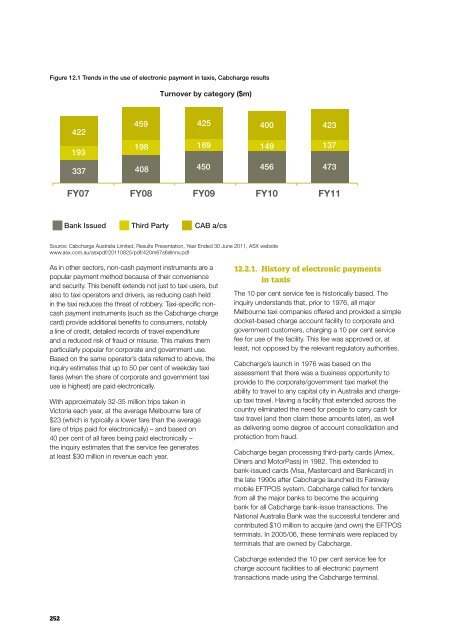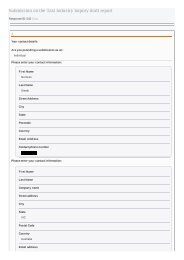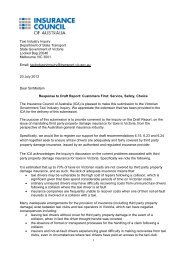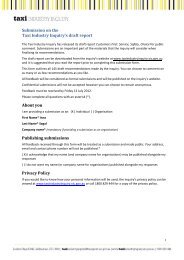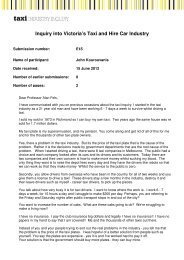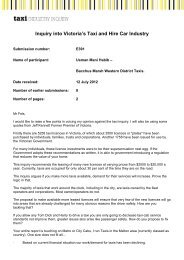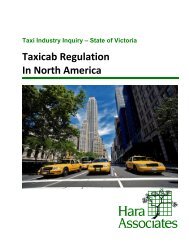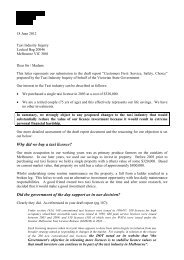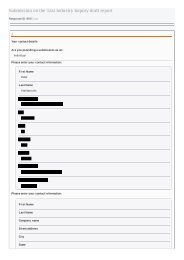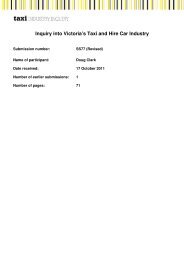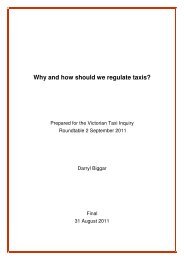Part D â Understanding and improving industry performance (PDF ...
Part D â Understanding and improving industry performance (PDF ...
Part D â Understanding and improving industry performance (PDF ...
Create successful ePaper yourself
Turn your PDF publications into a flip-book with our unique Google optimized e-Paper software.
Figure 12.1 Trends in the use of electronic payment in taxis, Cabcharge results<br />
Figure 12.1 Trends in the use of electronic payment in taxis, Cabcharge results<br />
Turnover by category ($m)<br />
422<br />
193<br />
459<br />
198<br />
425<br />
169<br />
400<br />
149<br />
423<br />
137<br />
337<br />
408<br />
450<br />
456<br />
473<br />
FY07 FY08 FY09 FY10 FY11<br />
Bank Issued Third <strong>Part</strong>y CAB a/cs<br />
Source: Cabcharge Australia Limited, Results Presentation, Year Ended 30 June 2011, ASX website<br />
www.asx.com.au/asxpdf/20110825/pdf/420m67s6sllnnv.pdf<br />
As in other sectors, non-cash payment instruments are a<br />
popular payment method because of their convenience<br />
<strong>and</strong> security. This benefit extends not just to taxi users, but<br />
also to taxi operators <strong>and</strong> drivers, as reducing cash held<br />
in the taxi reduces the threat of robbery. Taxi-specific noncash<br />
payment instruments (such as the Cabcharge charge<br />
card) provide additional benefits to consumers, notably<br />
a line of credit, detailed records of travel expenditure<br />
<strong>and</strong> a reduced risk of fraud or misuse. This makes them<br />
particularly popular for corporate <strong>and</strong> government use.<br />
Based on the same operator’s data referred to above, the<br />
inquiry estimates that up to 50 per cent of weekday taxi<br />
fares (when the share of corporate <strong>and</strong> government taxi<br />
use is highest) are paid electronically.<br />
With approximately 32-35 million trips taken in<br />
Victoria each year, at the average Melbourne fare of<br />
$23 (which is typically a lower fare than the average<br />
fare of trips paid for electronically) – <strong>and</strong> based on<br />
40 per cent of all fares being paid electronically –<br />
the inquiry estimates that the service fee generates<br />
at least $30 million in revenue each year.<br />
12.2.1. History of electronic payments<br />
in taxis<br />
The 10 per cent service fee is historically based. The<br />
inquiry underst<strong>and</strong>s that, prior to 1976, all major<br />
Melbourne taxi companies offered <strong>and</strong> provided a simple<br />
docket-based charge account facility to corporate <strong>and</strong><br />
government customers, charging a 10 per cent service<br />
fee for use of the facility. This fee was approved or, at<br />
least, not opposed by the relevant regulatory authorities.<br />
Cabcharge’s launch in 1976 was based on the<br />
assessment that there was a business opportunity to<br />
provide to the corporate/government taxi market the<br />
ability to travel to any capital city in Australia <strong>and</strong> chargeup<br />
taxi travel. Having a facility that extended across the<br />
country eliminated the need for people to carry cash for<br />
taxi travel (<strong>and</strong> then claim these amounts later), as well<br />
as delivering some degree of account consolidation <strong>and</strong><br />
protection from fraud.<br />
Cabcharge began processing third-party cards (Amex,<br />
Diners <strong>and</strong> MotorPass) in 1982. This extended to<br />
bank-issued cards (Visa, Mastercard <strong>and</strong> Bankcard) in<br />
the late 1990s after Cabcharge launched its Fareway<br />
mobile EFTPOS system. Cabcharge called for tenders<br />
from all the major banks to become the acquiring<br />
bank for all Cabcharge bank-issue transactions. The<br />
National Australia Bank was the successful tenderer <strong>and</strong><br />
contributed $10 million to acquire (<strong>and</strong> own) the EFTPOS<br />
terminals. In 2005/06, these terminals were replaced by<br />
terminals that are owned by Cabcharge.<br />
Cabcharge extended the 10 per cent service fee for<br />
charge account facilities to all electronic payment<br />
transactions made using the Cabcharge terminal.<br />
252


